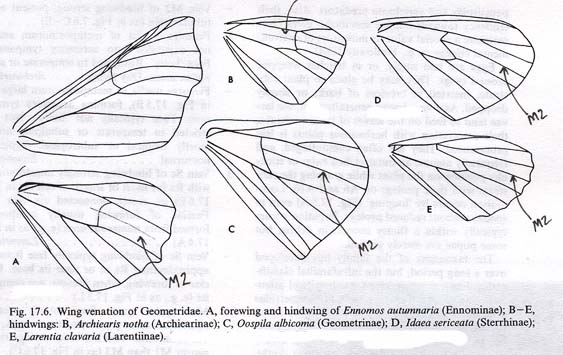1. a. Vein M2 of hindwing weak (not existing as a tubular vein) (as in
Fig. 17.6 A,B) or not visible ----- Ennominae (Cleora)
....b. Vein M2 of hindwing strong, present
as a tubular vein (as in Fig. 7.6 C-E) --------------------------------------
2

2. a. Vein Sc of hindwing strongly anastomosing with Rs for most of length
of cell (as in Fig. 17.6E) or, rarely, connected via vein R1.
........Fasciae of forewing usually composite,
formed from numerous lines (e.g., as in Fig. 1) ------------ Larentiinae
(Bosara,
........Chloroclystis, Gymnoscelis,
Pasiphilodes)
... b. Vein Sc of hindwing typically free
from or approximating Rs at or near its base.
........Fasciae of forewing, when present,
not composite (eg., as in Fig. 2) ---------------------------------------
3


..............Fig. 1. Larentiinae - Gymnoscelis ..........................................Fig. 2. Sterrhinae - Anisodes
3. a. Most species green. Socii usually present, sometimes more prominent
than uncus; uncus often bifid.
........Vein M2 of hindwing arising nearer
M1 than M3 (as in Fig. 17.6C) ----------------------------- Geometrinae
(Thalassodes)
....b. Species not green. Socii not usually
present.
........Vein M2 of hindwing tends to arise
approximately midway between M1 and M3 (e.g., as in Fig 17.6 E).
........Moths mostly slender-bodied, pink
or pale fawn, occasionally yellowish or white. Wings often with many fasciae
........(e.g., as in Fig. 2) (fasciae not
typically composite, unlike Larentiinae).
........Uncus or gnathos often reduced----------------------------------------------------------------- Sterrhinae (Anisodes)
Notes: Uncus & socii are parts of the male genitalia. I cannot tell
from from Fig 17.6 E that Sc is anastimosed with Rs.
...........The fascia (spots, markings) on
the forewings of Gymnoscelis & Anisodes both seem composite to me.
...........The largest moths will probably
be Cleora or Anisodes, so M2 in the hindwing should tell
them apart.
...........This key was adapted from Minet
J. & Scoble MJ.1999. The Drepanoid/Geometroid assemblage. In Kristensen
(ed.)
...........Handbook of Zoology. Lepidoptera,
Moths and Butterflies. Volume 1: Evolution, Systematics, and Biogeography.